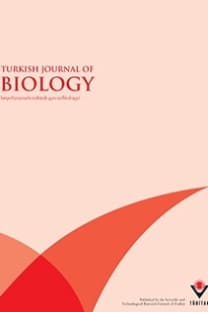Purification and characterization of trehalase from seeds of chickpea (Cicer arietinum L.)
Key words: Cicer arietinum, trehalase, trehalose, purification, molecular mass, validamycin A
Purification and characterization of trehalase from seeds of chickpea (Cicer arietinum L.)
Key words: Cicer arietinum, trehalase, trehalose, purification, molecular mass, validamycin A,
___
- Aeschbacher RA, Müller J, Boller T, Wiemken A (1999). Purification of the trehalase GMTRE1 from soybean nodules and cloning of its cDNA. GMTRE1 is expressed at a low level in multiple tissues. Plant Physiol 119: 489–495.
- Alizadeh P, Klionsky DJ (1996). Purification and biochemical characterization of the ATH1 gene product, vacuolar acid trehalase, from Saccharomyces cerevisiae. FEBS Lett 391: 273– 2
- Bergmeyer HU, Bernt EM (1974). Methods of Enzymatic Analysis. New York: Academic Press.
- Carroll JD, Pastuszak I, Edavana VK, Pan YT, Elbein AD (2007). A novel trehalase from Mycobacterium smegmatis: purification, properties, requirements. FEBS J 274: 1701–1714.
- Dmitryjuk M, Zółtowska K (2003). Purification and characterization of acid trehalase from muscle of Ascaris suum (Nematoda). Comp Biochem Phys B 136: 61–69.
- Elbein AD, Pan YT, Pastuszak I, Carroll D (2003). New insights on trehalose: a multifunctional molecule. Glycobiology 13: 17R–27R.
- Fernandez O, Béthencourt L, Quero A, Sangwan RS, Clément C (2010). Trehalose and plant stress responses: friend or foe? Trends Plant Sci 15: 409–417.
- Frison M, Parrou JL, Guillaumot D, Masquelier D, Francois J, Chaumont F, Batoko, H (2007). The Arabidopsis thaliana is a plasma membrane-bound enzyme with extracellular activity. FEBS Lett 581: 4010–4016.
- García NAT, Tribarne C, López M, Herrera-Cervera JA, Liuch C (2005). Physiological implications of trehalase from Phaseolus vulgaris root nodules: partial purification and characterization. Plant Physiol Bioch 43: 355–361.
- Inagaki K, Ueno N, Tamura T, Tanaka H (2001). Purification and characterization of an acid trehalase from Acidobacterium capsulatum. J Biosci Bioeng 91: 141–146.
- Jorge CD, Sampaio MM, Hreggvidsson GO, Kristjánson JK, Santos H (2007). A highly thermostable trehalase from the thermophilic bacterium Rhodothermus marinus. Extremophiles 11: 115–122.
- Kamei Y, Hasegawa Y, Niimi T, Yamashita O, Yaginuma T (2011). Trehalase-2 protein contributes to trehalase activity enhanced by diapauses hormone in developing ovaries of the silkworm, Bombyx mori. J Insect Physiol 57: 608–613.
- Kamiya T, Hirata K, Matsumoto S, Arai C, Yoshizane C, Kyono F, Ariyasu T, Hanaya T, Arai S, Okura T, et al. (2004). Targeted disruption of the trehalase gene: determination of the digestion and absorption of trehalose in trehalase-deficient mice. Nutr Res 24: 185–196.
- Kord MAE, Youssef EA, Ahmed HE, Qaid EA (2012). Purification and some properties of trehalase from Triticum aestivum seeds. In: Proceedings of the 2nd International Conference of Physiological, Microbiological, and Ecological Plant Sciences. University of Mina, Egypt.
- Liu Y, Wang Z, Yin Y, Cao Y, Zhao H, Xia Y (2007). Expression, purification, and characterization of recombinant Metarhizium anisopliae acid trehalase in Pichia pastoris. Protein Expres Purif 54:66–72.
- López M, Tejera NA, Lluch C (2009). Validamycin A improves the response of Medicago truncatula plants to salt stress by inducing trehalose accumulation in the root nodules. J Plant Physiol 166: 1218–1222.
- Lopez MF, Torrey JG (1985). Purification and properties of trehalase in Frankia ArI3. Arch Microbiol 143: 209–215.
- Lowry OH, Rosebrough NJ, Farr AL, Randall, RJ (1951). Protein measurement with the Folin phenol reagent. J Biol Chem 193: 265–275.
- Müller J, Staehelin C, Mellor RB, Boller T, Wiemken A (1992). Partial purification and characterization of trehalase from soybean nodules. J Plant Physiol 140: 8–13.
- Murata M, Nagai M, Takao M, Suzuki A., Sakai T, Terashita T (2001). Purification and characterization of an extracellular acid trehalase from Lentinula edodes. Mycoscience 42: 479–482.
- Reguera M, Peleg Z, Blumwald E (2012). Targeting metabolic pathways for genetic engineering abiotic stress-tolerance in crops. Biochim Biophys Acta 1819: 186–194.
- Schubert A, Wyss P (1995). Trehalase activity in mycorrhizal and non-mycorrhizal roots of leek and soybean. Mycorrhiza 5: 401–404.
- Silva MCP, Terra WR, Ferreira C (2004). The role of carboxyl, guanidine and imidazole groups in catalysis by a midgut trehalase purified from an insect larvae. Insect Biochem Molec 34: 1089–1099.
- Temesvari LA, Cotter DA (1997). Trehalase of Dictyostelium discoideum: inhibition by amino-containing analogs of trehalose and affinity purification. Biochimie 79: 229–239.
- Walker JM (1994). Basic protein and peptide protocols. Ann Bot London 81: 449–454.
- Warburg O, Christian W (1942). Isolation and crystallization of enolase. Biochem Z 310: 384–421.
- Wolska-Mitaszko B, Molestak E, Malek W (2005). Properties of trehalase from different organs of alfalfa, Medicago sativa. Acta Physiol Plant 27: 53–60.
- Yaginuma T, Mizuno T, Mizuno C, Ikeda M, Wada T, Hattori K, Yamashita O, Happ GM (1996). Trehalase in the spermatophore from the bean-shaped accessory gland of the male mealworm beetle, Tenebrio molitor: purification, kinetic properties, and localization of the enzyme. J Comp Physiol 166: 1–10.
- ISSN: 1300-0152
- Yayın Aralığı: 6
- Yayıncı: TÜBİTAK
Zsuzsanna GYÖRGY, Erling FJELLDAL, Anna SZABÓ, Paul Eric ASPHOLM, Andrzej PEDRYC
Cytogenetic effects of endogenous sex hormones depending on smoking habits
Handan ERBOĞA, Hasan Basri İLA
Purification and characterization of trehalase from seeds of chickpea (Cicer arietinum L.)
Maimona KORD, Elhusseiny YOUSSEF, Hanaa AHMED, Ebtesam QAID
Shamima Akhtar SHARMIN, Mohammad Jahangir ALAM, Md. Mominul İslam SHEIKH, Rashed ZAMAN, Muhammad KHALEKUZZAMAN, Sanjoy Chandra MONDAL, Mohammad Anwarul HAQUE, Mohammad Firoz ALAM, İftekhar ALAM
Júlia HALÁSZ, Attila HEGEDÜS, Bernadett SZIKRISZT, Sezai ERCİŞLİ, Emine ORHAN, Hakan Murat ÜNLÜ
Ana OBRADOVIC, Jovana ZIZIC, Nemanja TRISOVIC, Bojan BOZIC, Gordana USCUMLIC, Biljana BOZIC, Snezana MARKOVIC
Alexandra JITAREANU, Silvica PADUREANU, Gabriela TATARINGA, Cristina TUCHILUS, Ursula STANESCU
Genotoxic and safety assessment of 2 parabens in somatic cells of in vivo Drosophila melanogaster
Sezer OKAY, Murat ÖZDAL, Esabi Başaran KURBANOĞLU
Reza FARJAMINEZHAD, Nasser ZARE, Rasool ASGHARI-ZAKARIA, Manoochehr FARJAMINEZHAD
